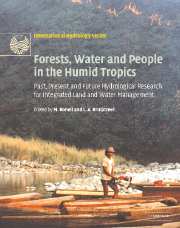 Forests, Water and People in the Humid Tropics
Forests, Water and People in the Humid Tropics Book contents
- Frontmatter
- Contents
- List of contributors
- Foreword
- Preface
- Acknowledgements
- Symposium and Workshop
- Introduction
- Part I Current trends and perspectives on people–land use–water issues
- Part II Hydrological processes in undisturbed forests
- 10 An overview of the meteorology and climatology of the humid tropics
- 11 Synoptic and mesoscale rain producing systems in the humid tropics
- 12 Climatic variability in the tropics
- 13 Controls on evaporation in lowland tropical rainforest
- 14 Runoff generation in tropical forests
- 15 Erosion and sediment yield in the humid tropics
- 16 Rainforest mineral nutrition: the ‘black box’ and a glimpse inside it
- 17 Hydrology of tropical wetland forests: recent research results from Sarawak peatswamps
- 18 Tropical montane cloud forest: a unique hydrological case
- Part III Forest disturbance, conversion and recovery
- Part IV New methods for evaluating effects of land-use change
- Part V Critical appraisals of best management practices
- Conclusion: Forests, water and people in the humid tropics: an emerging view
- Plate section
- References
13 - Controls on evaporation in lowland tropical rainforest
from Part II - Hydrological processes in undisturbed forests
Published online by Cambridge University Press: 12 January 2010
- Frontmatter
- Contents
- List of contributors
- Foreword
- Preface
- Acknowledgements
- Symposium and Workshop
- Introduction
- Part I Current trends and perspectives on people–land use–water issues
- Part II Hydrological processes in undisturbed forests
- 10 An overview of the meteorology and climatology of the humid tropics
- 11 Synoptic and mesoscale rain producing systems in the humid tropics
- 12 Climatic variability in the tropics
- 13 Controls on evaporation in lowland tropical rainforest
- 14 Runoff generation in tropical forests
- 15 Erosion and sediment yield in the humid tropics
- 16 Rainforest mineral nutrition: the ‘black box’ and a glimpse inside it
- 17 Hydrology of tropical wetland forests: recent research results from Sarawak peatswamps
- 18 Tropical montane cloud forest: a unique hydrological case
- Part III Forest disturbance, conversion and recovery
- Part IV New methods for evaluating effects of land-use change
- Part V Critical appraisals of best management practices
- Conclusion: Forests, water and people in the humid tropics: an emerging view
- Plate section
- References
Summary
INTRODUCTION
Although there has been substantial deforestation in recent decades, lowland rainforests still constitute an important fraction of land cover in the tropical regions (cf. Drigo, this volume). There are around 1800 million hectares of natural forest cover in the tropics, about 37% of the land area. Of this forest cover around 1000 million hectares are lowland rainforest (FAO, 2001). The bulk of lowland rainforest is in the Equatorial Regions, in the Amazon basin, South East Asia and Central Africa (Richards, 1996).
In the past two decades there has been a sustained interest in the factors that control water fluxes from tropical rainforest. The motivations for that interest are many. It has long been realised that the hydrology of vegetation has important links with the partitioning of available energy at the surface of the Earth and the impact of land cover changes on surface climate. There is also a need to understand the influence of global changes in climate on water resources and the behaviour of large areas of tropical vegetation will be important to this understanding. Detailed knowledge and understanding of aspects of tropical forest hydrology is key to a reliable prediction of the effects of rainforest management on the amount and timing of streamflow.
Catchment studies have considerable value in enabling direct comparisons of the effects of changes in land cover on the amount and the timing of streamflow to be made.
- Type
- Chapter
- Information
- Forests, Water and People in the Humid TropicsPast, Present and Future Hydrological Research for Integrated Land and Water Management, pp. 287 - 313Publisher: Cambridge University PressPrint publication year: 2005
References
- 23
- Cited by


